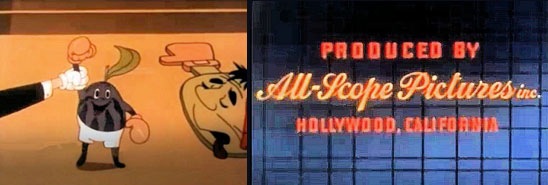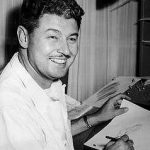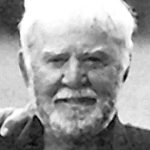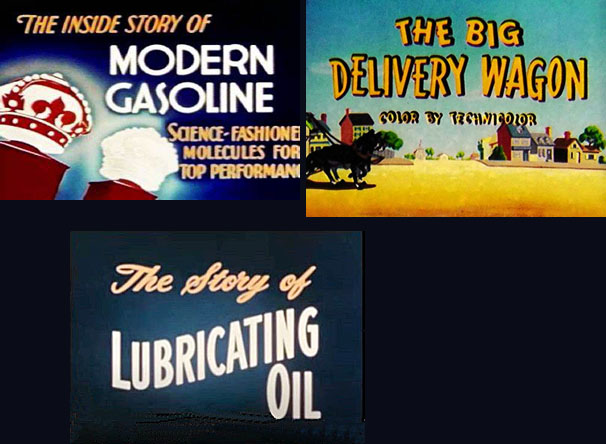 After World War Two general service studios popped up in cities all around the country to rake in a slice of the ensuing economic boom. Hollywood saw more than its fair share. These little studios came and went, many just blips on the radar of film history. Here are four of the more respectable efforts:
After World War Two general service studios popped up in cities all around the country to rake in a slice of the ensuing economic boom. Hollywood saw more than its fair share. These little studios came and went, many just blips on the radar of film history. Here are four of the more respectable efforts:
All Scope Pictures appeared in 1946, renting production space from Morey and Sutherland at their Occidental Boulevard facility, while maintaining a business office in the Taft Building on the corner of Hollywood and Vine streets. Gordon S. Mitchell, former Manager of the Research Council for the Academy of Motion Picture Arts and Sciences, started All Scope largely to employ veterans with film making training. All Scope’s original thrust was into live-action industrial films concerning agriculture. A FORTUNE IN TWO TRUNKS, made for the California Prune & Apricot Growers Association, put them right on the map. Mitchell’s vice president C. D. Owens had spent the last decade as sales promoter for that association.
 All Scope also did work for the U.S. Air Force and Army Signal Corps. SO THIS IS FLIGHT SERVICE!, narrated by comedian Bob Hope, contains animated segments in its half-hour running time. Perhaps one of the military animation units did the job, because All Scope doesn’t seem to have had an animation department yet. They advertised their services as – sponsored films for education, advertising and TV, specializing in one minute and twenty second sports’ commercials – In fact, when All Scope produced GOOD WRINKLES for the California prune people in 1951 Harman and Ising did the animation.
All Scope also did work for the U.S. Air Force and Army Signal Corps. SO THIS IS FLIGHT SERVICE!, narrated by comedian Bob Hope, contains animated segments in its half-hour running time. Perhaps one of the military animation units did the job, because All Scope doesn’t seem to have had an animation department yet. They advertised their services as – sponsored films for education, advertising and TV, specializing in one minute and twenty second sports’ commercials – In fact, when All Scope produced GOOD WRINKLES for the California prune people in 1951 Harman and Ising did the animation.
Jonathan Boschen has previously written a fine article on GOOD WRINKLES for this blog. All Scope already moved to bigger quarters in the Yucca Vine Building at 6305 Yucca Street. Norval D. Crutcher Jr., son of an unsuccessful actor, became Production Manager at All Scope Pictures in 1952. Crutcher had just been a partner in Centaur Productions with stop-motion experts Wah Chang and Gene Warren at 125 East Linden Avenue in Burbank. Crutcher went on to a prolific career as a sound effects man in early television, mainly Westerns. His son Norval D. Crutcher 3rd worked into the Twenty-first Century as a sound editor on shows such as SMALLVILLE, THE FLASH, and ARROW.

One thing those general service studios relying on animation wanted to do was snag their own Disney guy. In 1956 All Scope had Dan McManus, who had joined Disney in 1935 as an animator, rising to effects animator for PINOCCHIO. McManus went back-and-forth between the two departments. Dan McManus continued racking up credits at Disney while acting as Animation Director for All Scope.
The company reorganized in 1956 when All Scope Productions was attached to 20th Century Fox Television as the Commercial Film Division. Production moved to Fox facilities at 1417 North Western Avenue. Norman McCabe took over as Animation Director in 1958. McCabe had been a director at Leon Schlesinger Productions, giving us classic Porky and Daffy toons before being drafted. More recently he’d been with Oscar Productions until Walter Lantz bought that company out. All Scope continued making short films for Sunsweet Growers, and the U.S. Air Force, as well as television commercials for Lucky Lager Beer, Royal Typewriter, and Luzianne Coffee. In 1965 they moved to Sepulveda and BLIPPED out of view.
Animated Video Films Inc. shows up at 931 North La Cienga Boulevard in 1949 to produce animated and live action TV films, industrial films, and educational films. The people who founded it were an all-star team.
 Adolph Charles “Ace” Gamer, born in Chicago, volunteered for the British Air Service during the First World War before studying art at Chouinard. Gamer joined Leon Schlesinger Productions as an animator in 1936 quickly bumping up to effects animator. He was a past president of the Hollywood Screen Cartoonists union local. Ace Gamer headed production at Animated Video Films.
Adolph Charles “Ace” Gamer, born in Chicago, volunteered for the British Air Service during the First World War before studying art at Chouinard. Gamer joined Leon Schlesinger Productions as an animator in 1936 quickly bumping up to effects animator. He was a past president of the Hollywood Screen Cartoonists union local. Ace Gamer headed production at Animated Video Films.
 Dick Huemer ran the story department. Huemer harkened back to the pioneering days of animation, assisting with Mutt and Jeff for Charles Bowers in the Bronx. Dick Huemer helped Out of the Inkwell Studios organize their animation department, freeing Koko the Clown from the restraints of rotoscoping. Upon reaching Hollywood, Dick Huemer created Scrappy, making Columbia Pictures a bundle of money. He also convinced Walt Disney to use classical music for FANTASIA instead of marching songs.
Dick Huemer ran the story department. Huemer harkened back to the pioneering days of animation, assisting with Mutt and Jeff for Charles Bowers in the Bronx. Dick Huemer helped Out of the Inkwell Studios organize their animation department, freeing Koko the Clown from the restraints of rotoscoping. Upon reaching Hollywood, Dick Huemer created Scrappy, making Columbia Pictures a bundle of money. He also convinced Walt Disney to use classical music for FANTASIA instead of marching songs.
 Pete Burness supervised animation. His career stretched back to 1930, learning the trade alongside Jack Zander and Ken Harris in Hollywood under Romer Grey. Burness did a quick turn with Ted Eshbaugh, then off to New York with Van Beuren Studios. Back to Hollywood for Harman-Ising, then M-G-M slinging a pencil on Tom & Jerry toons. Pete Burness worked on some stuff at Warmer Brothers, then joined UPA, where he continued while being with Animated Video Films.
Pete Burness supervised animation. His career stretched back to 1930, learning the trade alongside Jack Zander and Ken Harris in Hollywood under Romer Grey. Burness did a quick turn with Ted Eshbaugh, then off to New York with Van Beuren Studios. Back to Hollywood for Harman-Ising, then M-G-M slinging a pencil on Tom & Jerry toons. Pete Burness worked on some stuff at Warmer Brothers, then joined UPA, where he continued while being with Animated Video Films.
 Bob Gribboek was in charge of Backgrounds and Layouts. Noted in a 1938 magazine article as “one of the best draftsman in America”, Gribboeck was a member of the Transcendental Painting Group in Taos, New Mexico. A series of art jobs brought him to Douglas Aircraft in Los Angeles, and then to Disney. Bob Gribboeck soon jumped over to Leon Schlesinger Productions as a background painter and layout artist.
Bob Gribboek was in charge of Backgrounds and Layouts. Noted in a 1938 magazine article as “one of the best draftsman in America”, Gribboeck was a member of the Transcendental Painting Group in Taos, New Mexico. A series of art jobs brought him to Douglas Aircraft in Los Angeles, and then to Disney. Bob Gribboeck soon jumped over to Leon Schlesinger Productions as a background painter and layout artist.
 Betty Brenon started in Schlesinger’s Ink & Paint Department during 1933 and was quickly promoted to supervisor. She joined the First Motion Picture Unit when the Second World War broke out. Right before running Animated Video Films’ I&p department, Brenon worked on THE SAILOR AND THE SEAGULL for UPA under John Hubley’s direction. She later opened her own Hollywood ink and paint service for seventeen years, with Walter Lantz as a steady client.
Betty Brenon started in Schlesinger’s Ink & Paint Department during 1933 and was quickly promoted to supervisor. She joined the First Motion Picture Unit when the Second World War broke out. Right before running Animated Video Films’ I&p department, Brenon worked on THE SAILOR AND THE SEAGULL for UPA under John Hubley’s direction. She later opened her own Hollywood ink and paint service for seventeen years, with Walter Lantz as a steady client.
Their cameraman Jack Buehre would later be used extensively by John and Faith Hubley on several award winning films, so it perplexes me that Animated Video Films doesn’t leave a larger footprint. They had already moved into a better location at 1001 North Vermont Avenue, but only lasted there until 1955 . . . and then went BLIP!
 Lou Lilly Productions came along in 1952. Lou Lilly left Kentucky for Hollywood to be a wardrobe boy and extra in the movie business. When Charles Mintz started making Krazy Kat cartoons for Columbia Pictures, Lilly joined him in 1931 and worked his way up to animator under Manny Gould’s supervision. When Gould went to Leon Schlesinger’s place, Lilly followed in 1940 as a writer. By 1945 he was with Jerry Fairbanks Productions as Production Manager for the Speaking of Animals series.
Lou Lilly Productions came along in 1952. Lou Lilly left Kentucky for Hollywood to be a wardrobe boy and extra in the movie business. When Charles Mintz started making Krazy Kat cartoons for Columbia Pictures, Lilly joined him in 1931 and worked his way up to animator under Manny Gould’s supervision. When Gould went to Leon Schlesinger’s place, Lilly followed in 1940 as a writer. By 1945 he was with Jerry Fairbanks Productions as Production Manager for the Speaking of Animals series.
Lou Lilly soon ran the animation department for Fairbanks, bringing Manny Gould in from Warner Brothers around 1949 for a series of industrial films.
In 1950 Lilly took over the scenario department, handing the animation department off to Gould. Gould continued in that role when Lou Lilly Productions opened at 1001 Vermont Avenue to make television commercials. They moved to 5746 Sunset Boulevard, not far from Jerry Fairbanks’ studio, knocking out teleblurbs for: Ballantine Ale; Bell Brand Potato Chips; Buick; Chevrolet; Sugar Jets; Lever Bros; Ken-L-Ration Dog Food; Camel and Winston Cigarettes; and other clients. Business was so good Lou Lilly opened a branch office in Chicago at 221 North La Salle Street.

Manny Gould held the title Art Director in 1962 as N. Lee Lacy became Production Manager. Lacy actually shared the job title with Ken Clark. There was a fellow by that name from Waterford, England, a printer by trade and member of the Grasshopper Group, a collective of talented amateur animators who won awards at the Cannes Film Festival. Perhaps this is him.
Lou Lilly Productions moved to 1522 North Van Ness Avenue in 1964, changing its name to Minutemen Production. Ken Clark is listed as vice president, which often means investor. Manny Gould went to work for Ed Graham Productions on Linus the Lionhearted. N. Lee Lacy seems to have stuck it out on his own along Sunset Boulevard. Ron Seawright, whose father founded Cascade Pictures, hired on as Production Manager to no avail. After 1965 Lou Lilly’s shop went BLIP!
On the other hand, N. Lee Lacy’s star ascended.
 N. Lee Lacy Associates, Ltd. exuded an air of affluence. By age twenty-five Lacy was a producer/director for a Chicago television station. Made his way to Hollywood. Breaking loose from Lou Lilly in 1962, Lacy opened his own studio, eventually taking space at 8442 Melrose Place, an office which Broadcast Magazine described in a 1968 article as:
N. Lee Lacy Associates, Ltd. exuded an air of affluence. By age twenty-five Lacy was a producer/director for a Chicago television station. Made his way to Hollywood. Breaking loose from Lou Lilly in 1962, Lacy opened his own studio, eventually taking space at 8442 Melrose Place, an office which Broadcast Magazine described in a 1968 article as:
. . . a maze of garden-type bungalows built around a court where a lazy trickle of water snakes down through some overhanging vines into a miniature Walden pond. Ferns and wicker baskets are all about. So, too, are paisley ties and denims and white throw rugs, drum-shaped coffee tables and cheerful candies in glass jars. There is not a business suit in the place.
This is Melrose Place in the La Cienga Boulevard restaurant row, antique center of West Hollywood. This, too, is about as far out as a company can drop from the mainstream and established way of doing things and still succeed in business.
Lacy had branches in New York, Dallas, and London England by that point, employing forty people. The enigmatic Mel Kane had been his animation director early on. N. Lee Lacy catered to elegance. His New York office was on Park Avenue’s Restaurant Row at the Hotel Delmonico. Awards poured in. Broadcast Magazine gushed:
. . . the really swinging advertisers and agencies, know. They know, perhaps will even acknowledge, that Lee Lacy reflects – is indicative of – the new forms fermenting and spilling over, the old formulas broken, the techniques innovated, the constant seeking that makes up what’s happening in the commercial production business today.
Only, by then N. Lee Lacy Associates had become an advertising boutique focused on live-action commercials. So far as its place in animation history goes . . . BLIP !


 BOB COAR made his way in this world as a muralist and sign painter, illustrating on just about every surface imaginable. A life-long fan of animation, he is currently searching for digital, or actual, copies of Top Cel.
BOB COAR made his way in this world as a muralist and sign painter, illustrating on just about every surface imaginable. A life-long fan of animation, he is currently searching for digital, or actual, copies of Top Cel. 



































All those BLIPs make me feel like a schoolboy watching a filmstrip.
I’m intrigued by the connection between All Scope Productions and 20th Century Fox Television. I’ve long wondered who did the animation for the opening title of “Lost in Space”, a 20th Century Fox production; there was a different one for each of the show’s three seasons. The animation is rather basic, though helped along by the stirring theme music of John Williams. However, All Scope appears to have “blipped” out of existence around the time LIS premiered in 1965, so the titles would have been made by some other general service studio. Any information about this would be appreciated. That goes for “My Favorite Martian” as well.
N. Lee Lacy went bankrupt after investing in the 1999 box office flop “Love Stinks”. The N. stands for Nesbit.
You spelled Robert Gribbroek’s name two different ways, both of them wrong, but don’t worry, those Dutch surnames can be very tricky. (It means “grey trousers”.) Also, it’s La Cienega Boulevard, not “Cienga”. There was a character on Disney’s “The Proud Family” who was named after the street. La Cienega’s mother’s name was Sunset. Insert your own LA traffic joke here.
Ron Seawright’s farher was Roy Seawright, who did a lot of animation and special effects for Hal Roach’s comedies in the 1930’s.
Thanks for putting together this column. I love to learn about these little-known studios. I would question the statement about Dick Huemer: “He also convinced Walt Disney to use classical music for FANTASIA instead of marching songs.” By most accounts, Fantasia grew out of a chance meeting between Walt and Leopold Stokowski. Disney was certainly no stranger to classical music starting with The Skeleton Dance. Some credit may be due to Carl Stalling for suggesting the Silly Symphonies.
The statement is accurate, if a little broad. Walt Disney assigned story men Dick Huemer and Joe Grant to help come up with musical selections after making the decision to expand “The Sorcerer’s Apprentice” into a concert feature. Walt was taken with “The Entrance of the Fauns”, the opening march to Gabriel Pierne’s ballet “Cydalise and the Satyr”, which inspired the idea to make a segment set in the world of Greek mythology. Huemer thought that Beethoven’s Pastoral Symphony would give the scene some badly needed gravitas (Fantasia is heavy on ballet music as it is). Stokowski disagreed, feeling that the story deviated too far from Beethoven’s original intentions and would require drastic cuts to his music. But Deems Taylor was all for it, and Walt ultimately came around as well.
History repeats itself. That’s what’s been happening with post-production in the last 25 years or so, and a few have gone BLIP in the last ten.